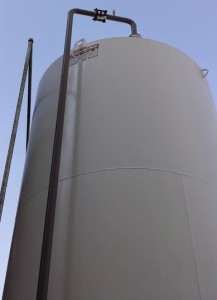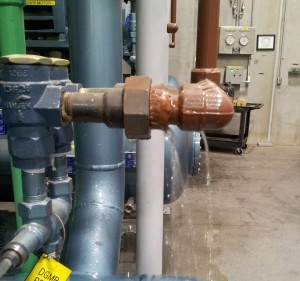Mechanical Integrity 101 | Ammonia Diffusion Tanks
 Since 1994, ammonia refrigeration systems subject to the requirements of the Uniform Mechanical Code or California Mechanical Code have been required to install an Ammonia Diffusion Tank for the purpose of relief valve termination. Originally, the codes required the following:
Since 1994, ammonia refrigeration systems subject to the requirements of the Uniform Mechanical Code or California Mechanical Code have been required to install an Ammonia Diffusion Tank for the purpose of relief valve termination. Originally, the codes required the following:
1994 UMC §1119 Ammonia Discharge
Ammonia systems shall be provided with an emergency discharge into a tank of water provided exclusively for ammonia absorption. At least 1 gallon (379 mL) of fresh water shall be provided for each pound (454 g) of ammonia in the system. The water used shall be prevented from freezing without the use of salt or chemicals. The tank shall be substantially constructed of not less than 1/8-inch or No. 10 M.S.G. (2.51 mm) steel. The horizontal dimensions of the tank shall be equal to or less than one half of the height. The tank shall have a hinged cover or, if of the enclosed type. shall have a vent hole at the top. Pipe connections shall be through the top of the tank. The discharge pipe from the pressure-relief valves shall discharge ammonia in the center of the tank near the bottom but not more than 30 feet (9104 mm) below the surface of the water.
In 2009, the requirements were modified reducing the required tank size:
2009 UMC §1120.0 Ammonia Discharge
Ammonia shall discharge into a tank of water that shall be used for no purpose except ammonia absorption. At least one (1) gallon (3.785 L) of fresh water shall be provided for each pound (454 g) of ammonia that will be released in one (1) hour from the largest relief device connected to the discharge pipe. The water used shall be prevented from freezing without the use of salt or chemicals. The tank shall be substantially constructed of not less than 1/8 inch (3.2 mm) or No. 10 MSG steel. The horizontal dimensions of the tank shall be equal to or less than one-half the height. The tank shall have a hinged cover or, if of the enclosed type, shall have a vent hole at the top. Pipe connections shall be through the top of the tank. The discharge pipe from the pressure-relief valves shall discharge ammonia in the center of the tank near the bottom but not more than thirty (30) feet (9,144 nun) below the surface of the water.
From a strictly code compliance perspective, inspecting a compliant Ammonia Diffusion Tank is pretty straight forward. However, water siphoning is another important factor that must be considered when performing a mechanical integrity inspection on a diffusion tank. In order to prevent water from siphoning from the Ammonia Diffusion Tank backwards through the relief valve discharge piping, the diffusion tank must be equipped with a vacuum/siphon breaker, check valve, or both. Let me explain:
- When a relief valve lifts (due to over-pressurization or valve malfunction) ammonia vapor is allowed to enter the relief valve discharge piping system and then the ammonia diffusion tank.
- Once the relief valve re-seats (closes), the flow of ammonia vapor into the relief valve discharge pipe and diffusion tank is stopped.
- Due to ammonia’s high affinity toward water, all ammonia vapor remaining in the relief valve discharge piping will be evacuated and mixed with the water in the diffusion tank.
- The evacuation of the ammonia vapor from the relief valve discharge pipe will create a vacuum inside the relief valve discharge pipe, thus causing ammonia/water solution from the diffusion tank to be siphoned up the relief valve discharge pipes until the water reaches the relief valves and the vacuum pressure is overcome.
- If no siphon/vacuum breaker is installed on the relief valve discharge pipe, the water will remain trapped inside the piping system with no way to escape until the vacuum becomes broken.
I recently witnessed Steps 1-5 at a refrigeration facility. When the vacuum was finally broken at a relief valve union in the Machinery Room, water poured out of the relief valve discharge piping for several minutes (see picture below).
 After further investigation, it was determined that the diffusion tank had neither a check valve or vacuum/siphon breaker installed to prevent this type of occurrence.
After further investigation, it was determined that the diffusion tank had neither a check valve or vacuum/siphon breaker installed to prevent this type of occurrence.
As always, use this information to make sure that your system is not operating with this same type of deficiency.

Are portable refrigeration trailers included in this review?
Eileen, Typically refrigeration trailers would not be equipped with ammonia diffusion tanks and therefore the same concern would not apply.
Do you need a water line hookup to a DIFFSUION tank
Typically, a water line will be hard piped to the diffusion tank. Sometimes the tank will be automatically refilled (ball float) and other times manually refilled (isolation valve). There is no requirement to have water hooked up permanently, but that is the typical configuration.
What type of labeling is required for ADTs?
While I acknowledge that IIAR 2-2021 Appendix Q (formerly Bulletin No. 114) contains the labeling recommendations for components that are part of the closed loop system, we suggest ammonia diffusion tanks (ADTs) should also follow that document’s guidance:
4.2 Component Markers
Component markers should bear the name of the equipment they identify, e.g., RECEIVER, ACCUMULATOR, RECIRCULATOR, etc. Additional information can be provided.
Component markers should have BLACK letters on a SAFETY ORANGE field.
You may find this resource helpful as well.
Firefighter here. We have several of these in my district and they have fire department connections directly to the diffusion tank. Do you have any direction for when to pump to it and what pressure?
Thanks!
When a diffusion tank is installed at an ammonia refrigeration facility, the water should be exclusively reserved for passive mitigation of a relief valve lifting. The tank did be full at all times, so there would be no scenario where you would pump into the tank.
Peter, I’m updating my checklist for Pressure Relief Systems during MIs, and I noticed IIAR2 says the diffusion tank has to be protected from freezing. I’ve not seen freeze-protection measures employed, even in northern states. What do I need to look for? A heating element of some sort I assume. What are the options?
Ryan, Thanks for reading the blog and reaching out to us. Most of the diffusions tanks I’ve seen are installed in California in areas where that quantity of water could not freeze due to ambient temperature. Methods to protect against freezing would be: 1) heating element in the tank; 2) configure the tank so that the water is circulated/moving; 3) Chemically treat the water with to lower the freezing point while making sure the solution is still compatible with ammonia.